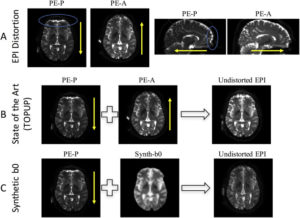Synthesized b0 for diffusion distortion correction (Synb0-DisCo).
Kurt G Schilling, Yuankai Huo, Allen Newton, Colin Hansen, Vishwesh Nath, Andrea T. Shafer, Owen Williams, Susan M. Resnick, Baxter Rogers, Adam W Anderson, Bennett A Landman. “Synthesized b0 for diffusion distortion correction (Synb0-DisCo).” Magnetic Resonance Imaging. 2019 May 7. pii: S0730-725X(18)30617-9. doi: 10.1016/j.mri.2019.05.008
Full text: https://www.ncbi.nlm.nih.gov/pubmed/?term=Synthesized+b0+for+diffusion+distortion+correction+(Synb0-DisCo).
Abstract
Diffusion magnetic resonance images typically suffer from spatial distortions due to susceptibility induced off-resonance fields, which may affect the geometric fidelity of the reconstructed volume and cause mismatches with anatomical images. State-of-the art susceptibility correction (for example, FSL’s TOPUP algorithm) typically requires data acquired twice with reverse phase encoding directions, referred to as blip-up blip-down acquisitions, in order to estimate an undistorted volume. Unfortunately, not all imaging protocols include a blip-up blip-down acquisition, and cannot take advantage of the state-of-the art susceptibility and motion correctioncapabilities. In this study, we aim to enable TOPUP-like processing with historical and/or limited diffusion imaging data that include only a structural image and single blip diffusion image. We utilize deep learning to synthesize an undistorted non-diffusion weighted image from the structural image, and use the non-distorted synthetic image as an anatomical target for distortion correction. We evaluate the efficacy of this approach (named Synb0-DisCo) and show that our distortion correction process results in better matching of the geometry of undistorted anatomical images, reduces variation in diffusion modeling, and is practically equivalent to having both blip-up and blip-down non-diffusion weighted images.
